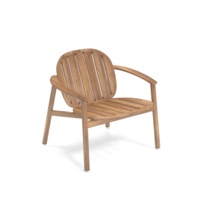
Sebastian Herkner
Sebastian Herkner (born in 1981) attended Product Design at HfG Offenbach University of Art and Design. During his studies he began to devote himself to the design of objects and furniture, refining his keen sense of materials, colors and textures. For a short time he works for Stella McCartney in London. In 2006 Sebastian Herkner founded his studio and since then has been designing furniture, lamps and small objects for brands such as Ames, and Tradition, Cappellini, ClassiCon, Dedon, Emu, Gubi, Linteloo, Moroso, Pulpo, Rosenthal, Schramm Werkstätten, Thonet, Wittmann and Zanotta. Herkner also deals with interior architecture projects, museums and exhibitions. His works have received numerous awards, including the IF Award, the Iconic Award and the Elle Deco International Design Award (EDIDA). As Guest of Honor at Imm Cologne 2016, Sebastian Herkner was in charge of the design for “Das Haus”. In 2019 Maison & Objet elected him "Designer of the Year" and in 2020 he won the most prestigious design award in Milan: the EDIDA award as best designer of the year. His is an unconditional love for traditional craftsmanship, combined with an acute sensitivity towards new technologies and an innate talent in conceiving authentic colors, materials and textures. What characterizes him is a genuine curiosity towards different cultures, the will to embrace and integrate them, a constant commitment and responsibility towards the things and the people he works with, not to mention the consideration and respect for every single process necessary for the purpose. to create a unique object. Since the success of the Bell Table for ClassiCon in 2012, Sebastian Herkner has never looked back, while remaining true to his words and to himself. Balance and intuition are important factors that ensure continuity in his work. A work that he sees as a continuous dialogue between the different disciplines and that takes him to the most remote corners of the world, in search of almost forgotten craft techniques, crafts with a centuries-old tradition, "Sleeping Beauty" manufactures that the designer wants to awaken from their numbness. In designing Sebastian not only designs chairs, sofas, lamps, tables, vases and carpets, but an entire cosmos through which the designer expresses the influence his objects have on the senses, the importance of beauty already cultivated from within the process itself and its empathy towards people. Balance and intuition are important factors that ensure continuity in his work. A work that he sees as a continuous dialogue between the different disciplines and that takes him to the most remote corners of the world, in search of almost forgotten craft techniques, crafts with a centuries-old tradition, "Sleeping Beauty" manufactures that the designer wants to awaken from their numbness. In designing Sebastian not only designs chairs, sofas, lamps, tables, vases and carpets, but an entire cosmos through which the designer expresses the influence his objects have on the senses, the importance of beauty already cultivated from within the process itself and its empathy towards people. Balance and intuition are important factors that ensure continuity in his work. A work that he sees as a continuous dialogue between the different disciplines and that takes him to the most remote corners of the world, in search of almost forgotten craft techniques, crafts with a centuries-old tradition, "Sleeping Beauty" manufactures that the designer wants to awaken from their numbness. In designing Sebastian not only designs chairs, sofas, lamps, tables, vases and carpets, but an entire cosmos through which the designer expresses the influence his objects have on the senses, the importance of beauty already cultivated from within the process itself and its empathy towards people. in search of almost forgotten artisan techniques, crafts with a centuries-old tradition, “Sleeping Beauty” manufactures that the designer wants to awaken from their torpor. In designing Sebastian not only designs chairs, sofas, lamps, tables, vases and carpets, but an entire cosmos through which the designer expresses the influence his objects have on the senses, the importance of beauty already cultivated from within the process itself and its empathy towards people. in search of almost forgotten artisan techniques, crafts with a centuries-old tradition, “Sleeping Beauty” manufactures that the designer wants to awaken from their torpor. In designing Sebastian not only designs chairs, sofas, lamps, tables, vases and carpets, but an entire cosmos through which the designer expresses the influence his objects have on the senses, the importance of beauty already cultivated from within the process itself and its empathy towards people.HfG Offenbach University of Art and Design.



































